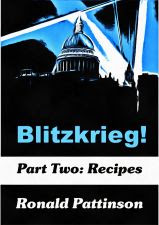 As a bonus, there's a little about sugar. Essentia bina, or caramel, had been used to colour Porter until it was outlawed in 1816. As you'll see, the fines for brewing from other than malt and hops were severe. If you reckon a barrel of beer sold for around two quid, a 100 pound fine is the equivalent of 50 barrels of beer.
As a bonus, there's a little about sugar. Essentia bina, or caramel, had been used to colour Porter until it was outlawed in 1816. As you'll see, the fines for brewing from other than malt and hops were severe. If you reckon a barrel of beer sold for around two quid, a 100 pound fine is the equivalent of 50 barrels of beer.Other grains
"Malting is not confined to barley, but oats, peas, beans, maize, buck-wheat, and common wheat, which are all capable of being malted, and have been experimented upon, but barley is the most prized grain." (Source: "The Art of Brewing and Fermenting" by John Levesque, 1836, page 20.)
"Wheat, on account of its weight, has had many trials, to bring it into more general use among brewers; but, from many communications the author has had with those who have brewed with wheat malt, either alone, or mixed, complain of a heaviness of flavour, and not altogether so pleasant as the liquor brewed from barley malt." (Source: "The Art of Brewing and Fermenting" by John Levesque, 1836, page 20.)
 Let me explain. Malt was taxed per bushel, a measure of volume. A bushel of wheat weighed on average 67 pounds, a bushel 56 pounds, at most. So you got about 20% more weight of grain for the same amount of tax when using wheat.
Let me explain. Malt was taxed per bushel, a measure of volume. A bushel of wheat weighed on average 67 pounds, a bushel 56 pounds, at most. So you got about 20% more weight of grain for the same amount of tax when using wheat.Wheat, being heavier, took longer to malt than barley. Oats, being lighter, took less time. (Source: "The Art of Brewing and Fermenting" by John Levesque, 1836, page 26.) 13 bushels of barley malt were the equivalent of 9 bushels of wheat, 10 of rye or 19 of oats, in terms of extract. (Source: "The Theory and Practice of Brewing" by W.L. Tizard, London, 1846, page 46.)
At times when barley was expensive, considerable amounts of wheat were malted and used in brewing. Tizard recommended malting wheat mixed with barley, to protect the tender skin of the wheat grains. Likewise in the mash, wheat malt was best mixed with coarser barley grains to avoid wheat flour clogging the mash tun. Wheat malt also required less crushing the barley malt as it was more inclined to turn into flour. (Source: "The Theory and Practice of Brewing" by W.L. Tizard, London, 1846, page 47.)
 Oats were not much used in this period. Oat malt incurred the same duty as barley, but produced not much more than half the extract. Only after 1880, when the malt tax was repealed, were oats an economic proposition and started being used again. Hence the appearance of oatmeal Stout at the end of the 19th century. (Source: "The Theory and Practice of Brewing" by W.L. Tizard, London, 1846, page 51.)
Oats were not much used in this period. Oat malt incurred the same duty as barley, but produced not much more than half the extract. Only after 1880, when the malt tax was repealed, were oats an economic proposition and started being used again. Hence the appearance of oatmeal Stout at the end of the 19th century. (Source: "The Theory and Practice of Brewing" by W.L. Tizard, London, 1846, page 51.)Big, a type of primitive barley, was malted and used for brewing in Scotland and Ireland. The quantities used were quite modest, about 10% of the amount of barley malted. Big malt was taxed at a lower rate than barley malt - 2 shillings, as opposed to 2 shillings and seven pence for barley. (Source: "Brewing and Distillation" by Thomas Thomson and William Stewart, Edinburgh, 1849, page 109.)
Sugar
In 1811 brewing with unmalted grain and sugar was outlawed by act of parliament in response to falling revenue from the malt tax. Sugar, in the form of caramel, was still permitted for colouring Porter. The following year, 1812, sugar was allowed to be used for brewing again. As the amount received through the malt tax was still disappointing, a full Reinheitsgebot was introduced in 1816. Malt and hops were the only ingredients permitted. (Source: "The Theory and Practice of Brewing" by W.L. Tizard, London, 1846, pages 490-491.)
 Some claimed sugar could not only be used in conjunction with malt, but to completely repalce it. Professor Donovan wrote of ale made entirely from sugar "To persons who have acquired an inveterate prediliction for the abominable and varied flavours which the skill of the brewer enables him to communicate, this pure and simple drink may be less pleasing; but it is singular how quickly the consumer acquires a high relish for it, and prefers it to every other. There is a purity of taste belonging to it quite different from the indescribable jumble of tastes so perceptible in common ales; and a light sharpness, combined with tenuity, which is more agreeable than the glutinous, mucilaginous softness of even the best ales. But it has one advantage which places it above all competition, and that is, its lightness on the stomach; this, when compared with the sickly heaviness of malt ales, is really remarkable." (Source: "The British Wine-Maker and Domestic Brewer" by WH Roberts, Edinburgh, 1835 page 278.)
Some claimed sugar could not only be used in conjunction with malt, but to completely repalce it. Professor Donovan wrote of ale made entirely from sugar "To persons who have acquired an inveterate prediliction for the abominable and varied flavours which the skill of the brewer enables him to communicate, this pure and simple drink may be less pleasing; but it is singular how quickly the consumer acquires a high relish for it, and prefers it to every other. There is a purity of taste belonging to it quite different from the indescribable jumble of tastes so perceptible in common ales; and a light sharpness, combined with tenuity, which is more agreeable than the glutinous, mucilaginous softness of even the best ales. But it has one advantage which places it above all competition, and that is, its lightness on the stomach; this, when compared with the sickly heaviness of malt ales, is really remarkable." (Source: "The British Wine-Maker and Domestic Brewer" by WH Roberts, Edinburgh, 1835 page 278.)Adulteration
The penalties for those caught using illegal ingredients were severe. Using sugar, molasses or honey - 100 pound fine. Using hop substitutes - 20 pound fine. Using drugs - one hundred pound fine and confiscation of utensils. (Source: "The Spirit, Wine Dealer's and Publican's Guide", by Edward Palmer, London, 1824 page 17.)










































































No comments:
Post a Comment